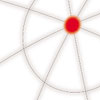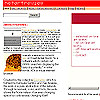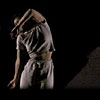 We
are
lucky
this
year
in
Cologne
:
We
are
lucky
this
year
in
Cologne
:
2 art fairs at the same time exhibiting contemporary art. A good opportunity to see if
some work made with a computer is exhibited...
and... let me have a dream... some interactivity ?
walking along the booths paintingssculpturesobjectsvideosphotos...
and-so-on...
[...] Read more in English French and German
::Isabel Saij::
 Originally
published
on
11/3/03
Originally
published
on
11/3/03Jaka Zeleznikar works almost exclusively on the margins of net.art in his anguage based works. Finding space to create valid and to the minute works in language, a feat achieved by few these days bar Mez, _lo-y and one or two others, and yet not seem connected to net.art's almost exclusive, but certainly by now historical language club, that of ascii art, is no mean feat!
Retypescape his latest "interactive internet based language related art work" creates modifiable typographical spaces out of existing web spaces by reprocessing websites through a server side application. It questions several issues related to websites, to name a few - public / private / copyright / authorship / authenticity / representation / context / intent / vandalism. It is all at once "digital grafitti" and content driven poetry in virtual spaces where "structures of the possible get their meanings in relation to what is already existing and are at the same time necessary upgraded by the action of the user."
By far one the most interesting and challenging language based works (sometimes known as code works or wurks) that you'll see on the www these days, Retypescape needs to be experienced.
:: Garrett Lynch ::
 Originally
published
07/04/03
Originally
published
07/04/03The interdiciplinary creative team Birgé - Clauss - Silhol recently released the online project Somnambules. The art work combines elements of film, dance, photo and painting to bring us a refreshing interpretation of abstract narratives carefully developed around multilayered musical loops. The shockwave presentation seamlessly merges online technology with well established codes in visual culture.
The project is approached with the usual structure of most dance recitals; that is, where the performance is often split into various linear segments culminating in a grand finale. While borrowing this approach, Somnambules presents twelve segments that can be viewed in any order, with the option of viewing the pieces in the proposed linear order as well. The result is an odd experience that leaves the viewer inbetween the many creative languages that are used in the project. This is also supported by the abstracted dance loops which can only be completed when the user interacts with the performers on the virtual stage.
This project is proof that creativity is heavily influenced by the advancement of technology. Three years ago the implementation of video as it is used in Somnambules would not have been possible; but now, thanks to Macromedia Director's latest perks, netizens can enjoy a well developed libretto from the comfort of the home. The best part of the net project is that the artists' balance of content and form has led to a piece that will most likely be referenced in the future for the merging of extremely complex visual languages.
:: Eduardo Navas ::